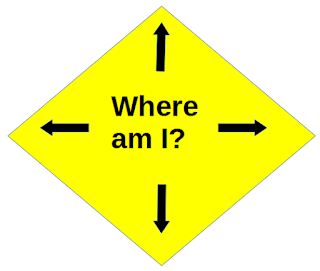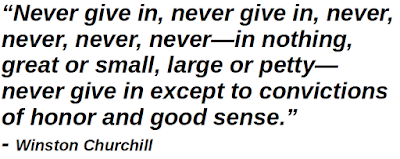 |
| dreamstime.com |
He explained how the walkers started an hour before the runners. Being competitive, he shot out of the starting gate, well ahead of the other walkers. When he came upon the first intersection of the course, his eyes darted quickly over the area, searching for a sign, a cone, an arrow painted on the pavement, a volunteer directing the competitors, … something, …anything! He saw nothing except a choice on which direction to go. He chose a direction and pressed on, increasing his pace through the town and into the countryside. Then the road dead-ended, in front of a farmhouse. He had to turn around and go back the way he came.
Three miles later he arrived at the infamous intersection. This time spectators were there to cheer him on and direct him back on course. Eventually he crossed the finish line, well out of placing, but with an admirable time (for 19 miles!) and the satisfaction of knowing that he didn’t give up, he simply turned around and completed the race.
- Melissa Kitcher went missing for nearly 12 hours after running off the trail during the Trail Hog Half-Marathon at the Carlton Reserve in Sarasota County, Florida. She realized she was lost but her phone “froze” at the beginning of the race and she couldn’t call for help. She ran over 16 miles before a park department employee finally located her.
- During a marathon in Bangalore, India, Indrajeet Patel was ahead of thousands of other runners. At about 10 miles, he realized that something was not right. Race officials had not marked the course nor were there volunteers to help direct runners. He missed a turn and ran in the wrong direction. Indrajeet had to ask people on the street for directions and even begged money from strangers so he could take the metro to get back on course.
- Ultra-runner, Jeff Stern, described his first race: “I was ready to go and have a great debut but I got lost 15 minutes into the race. I spent 20 minutes running in circles and trying to figure out where to go.”
Then, just when I was certain that I was lost, and was about to turn around - I spotted a traffic cone with an arrow sticking out of it at the top of the next hill. I was on course! I came in last place, but at least I wasn’t lost!
Keep Moving until You Figure it Out - There’s something about deliberately moving forward that reminds you that everything is going to be okay. It may not be the answer to all of life’s problems but there’s a good chance it will take you towards it.
Success is not just in landing that dream job, achieving that ideal balance in your life, or finding that perfect partner. It’s in the smaller steps you take to reach those goals, and how you learn and grow along the way. When I thought I was lost on that farm lane, I somehow knew I just had to keep going. I realized that sometimes you just have to take a risk, jump in, and figure it out.










